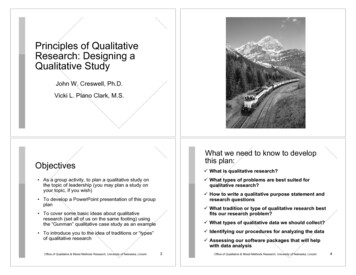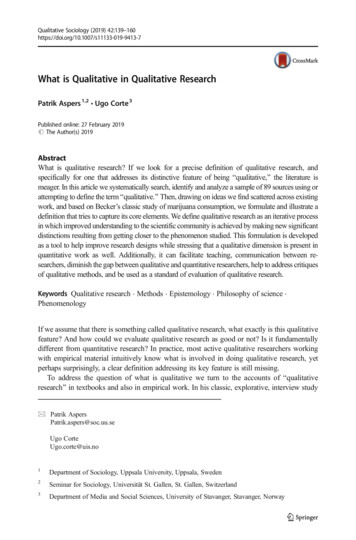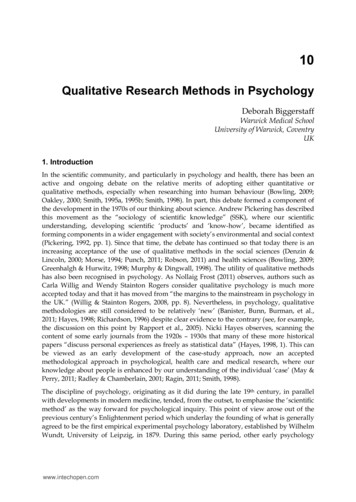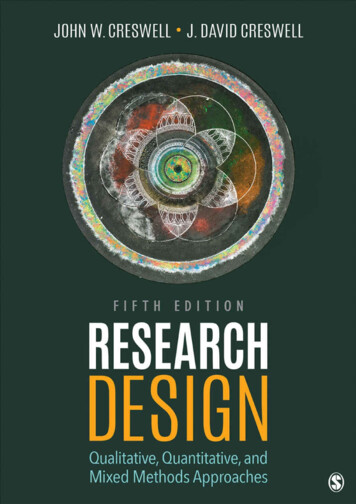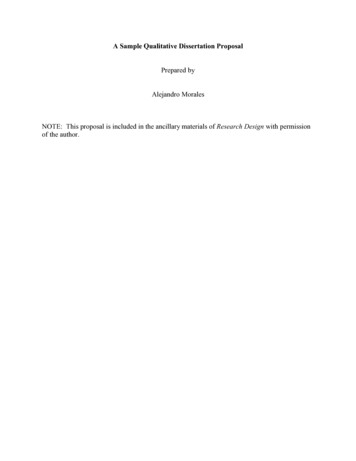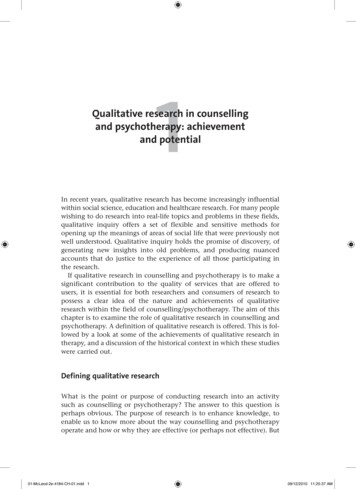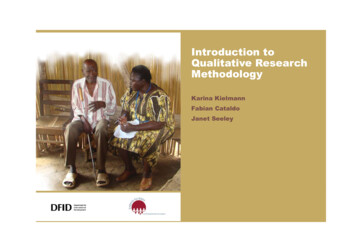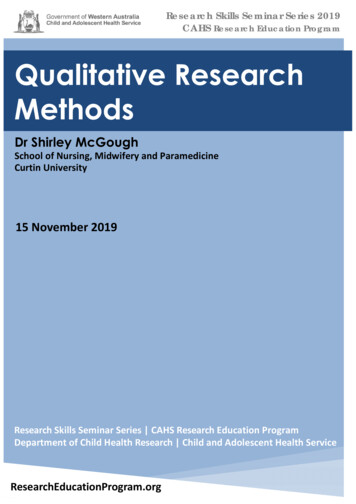
Transcription
Research Skills Seminar Series 2019CAHS Research Education ProgramQualitative ResearchMethodsDr Shirley McGoughSchool of Nursing, Midwifery and ParamedicineCurtin University15 November 2019Research Skills Seminar Series CAHS Research Education ProgramDepartment of Child Health Research Child and Adolescent Health ServiceResearchEducationProgram.org
CAHS Research Education Program, Department of Child Health Research,Child and Adolescent Health Service, WA 2019Copyright to this material produced by the CAHS Research EducationProgram, Department of Child Health Research, Child and AdolescentHealth Service, Western Australia, under the provisions of the Copyright Act1968 (C’wth Australia). Apart from any fair dealing for personal, academic,research or non-commercial use, no part may be reproduced withoutwritten permission. The Department of Child Health Research is under noobligation to grant this permission. Please acknowledge the CAHS ResearchEducation Program, Department of Child Health Research, Child andAdolescent Health Service when reproducing or quoting material from thissource.
QUALITATIVE RESEARCH METHODSCONTENTS:1PRESENTATION . 12QUALITATIVE RESEARCH METHODS – ADDITIONAL RESOURCES. 102.1Helpful websites . 102.2Reporting guidelines . 102.3Focus groups & interviews . 102.4Framework analysis . 112.5Traditional transcribed method with the audio recording method . 112.6Qualitative appraisal checklist . 112.7Key resources. 112.8Presentation references . 122.9Additional reading . 12
Ngaala kaaditj Nyoongar Wadjuk moort keyen kaadaknidja boodjaQualitative ResearchMethodsIn the spirit of Reconciliation, I acknowledge NyoongarWadjuk people as the original custodians of this land andpay my respects to elders past, present and emergingPresented by:Dr. Shirley McGough PhD.School of Nursing, Midwifery and Paramedicine, Curtin UniversityCurtin University is a trademark of Curtin University of TechnologyCRICOS Provider Code 00301JCurtin University is a trademark of Curtin University of TechnologyCRICOS Provider Code 00301JOverviewWhat is Qualitative Research?This presentation will cover:a) What is qualitative research? Primarily exploratory research used when little is known aboutthe subject area.b) Overview of qualitative research designsc) Myths about qualitative researchd) The qualitative research process Tells the story of a particular individual, group or community’sexperience in their words, and is therefore focused on narrative.1. Getting started2. Data collection3. Data analysis Is a scientific method of observation to gather non-numericaldata. It aims to describe the meanings, concepts, definitions,characteristics, metaphors, symbols, and description of things.4. Writing up findingse) Summary and questionsCurtin University is a trademark of Curtin University of TechnologyCRICOS Provider Code 00301JCurtin University is a trademark of Curtin University of TechnologyCRICOS Provider Code 00301JCurtin University is a trademark of Curtin University of TechnologyCRICOS Provider Code 00301J1
Qualitative ResearchQualitative ResearchQualitative research contributes to the development of newknowledge by: Many types of qualitative research methods and eachhas a distinct methodology. Enabling researchers to gain a better understanding ofparticipants’ experiences; Investigating how individuals, groups and communities react to,interpret and make sense of their world; Increasing use of mixed methods research (NHMRC, 2015). a)Quantitative-qualitative, b) Qualitative-quantitative and c)simultaneous qualitative and quantitative designNHMRC (2015). National statement on the ethical conduct in human research statement 2007, updated 2015. Canberra:Commonwealth of Australia. Downloaded 5th October, 2016 ivemethods Qualitative research can involve the use and collection of avariety of empirical materials such as case studies,personal experience, life stories and observation andcultural texts. Data is most often collected through interviews, focusgroups and observation.Curtin University is a trademark of Curtin University of TechnologyCRICOS Provider Code 00301JCurtin University is a trademark of Curtin University of TechnologyCRICOS Provider Code 00301JQualitative Research DesignMyths & misconceptions about QualitativeResearch DesignEach approach has a different philosophical stance that guides the questionsasked and the procedure used for data collection and analysis: Grounded theory – social and psychological experience Phenomenology –descriptions of experiences as consciously experienced bypeople living these experiences. Ethnography – observation and cultural patterns, values, perceptions Historical research - involves examining past events to draw conclusions andmake predictions about the future. Collaborative yarning – Indigenous method of sharing information, exploringideas in explaining new topics, leading to new understandings - positioning Feminist - Understanding how women are positioned in society Case Studies - Understanding how or why an individual, group, organisation,or community has experienced a problem or interventionCurtin University is a trademark of Curtin University of TechnologyCRICOS Provider Code 00301J The analysis of data is not rigorous or systematic The best data emerge from systematic, thoughtful, and rigorousprocedures for which methodological regulations have been written.(Harper & Kuh 2007). Rigour/credibility in qualitiative - researchers aim for “trustworthiness”.Veracity, Consistency, Confirmability, Applicability (Noble & Smith, 2015) Findings are not transferrable to other settings The goal is not to generalize but rather to provide a rich, contextualizedunderstanding of some aspect of human experience through theintensive study of particular cases (Polit & Beck, 2010).Curtin University is a trademark of Curtin University of TechnologyCRICOS Provider Code 00301JCurtin University is a trademark of Curtin University of TechnologyCRICOS Provider Code 00301J2
Myths & misconceptions about QualitativeResearch DesignQualitative Research Process1. Getting Started The sample size is too small and is not representativeof the population. Typically focus on depth of findings rather than breadth and work withsmall samples of people (Aspland, 2013). Purposive sampling and datasaturation.2. Data Collection3. Data Analysis4. Writing Up Findings Qualitative Data Are Useful Only When CorroboratedBy Numbers Not all qualitative studies require quantitative verification, and vice versa(Harper & Kuh 2007).Curtin University is a trademark of Curtin University of TechnologyCRICOS Provider Code 00301JCurtin University is a trademark of Curtin University of TechnologyCRICOS Provider Code 00301J1. Getting Started2. Data collection – Participant RecruitmentQualitative research, like quantitative research, follows apredetermined process: Ethical approval (including audio/video recording) Problem identification Justification for the study and significance of findings Study design and method selection Methods for managing distress Subject selection and inclusion/exclusion criteria Data collection and analysis Description ------------- interpretation Trustworthiness of data Reporting and publicationCurtin University is a trademark of Curtin University of TechnologyCRICOS Provider Code 00301J Depending on subject being researched: Snowballing – one participant invites another to participateand contact researcher Convenience sample: Available group for topic beingstudied- hospital setting Single participant/group design: Case studiesCurtin University is a trademark of Curtin University of TechnologyCRICOS Provider Code 00301JCurtin University is a trademark of Curtin University of TechnologyCRICOS Provider Code 00301J3
2. Data collection – Sampling2. Data collection Depends on design - purposeful sampling commonlyused.Things to consider before data collection starts. In Grounded Theory, as data collection and analysis aredone simultaneously purpose sampling is used then asanalysis progresses, theoretical sampling may be used. AssumptionsBracketing Field notes/memosCurtin University is a trademark of Curtin University of TechnologyCRICOS Provider Code 00301JCurtin University is a trademark of Curtin University of TechnologyCRICOS Provider Code 00301J2. Data collection2. Data collectionMost commonly through interviews or focus groups. May beteamed with observation.Quality of data collection Semi-structured interviews are conducted usually in aplace that is convenient to participants. However, beaware of your safety if you are going to participants’homes. McCracken (1988) referred to the long interview as “one of the mostpowerful methods in the qualitative armoury” (p. 9). He proposes that, “the long interview gives one the opportunity to stepinto the mind of another person, to see and experience the world asthey do themselves” (p.9). Interviewing requires a high level of training and skill. It is important to have well-trained interviewers to reduce the possibilityof bias.McCracken, G. (1988). The long interview: Qualitative research methods. London: SageUniversity Press.Curtin University is a trademark of Curtin University of TechnologyCRICOS Provider Code 00301JCurtin University is a trademark of Curtin University of TechnologyCRICOS Provider Code 00301JCurtin University is a trademark of Curtin University of TechnologyCRICOS Provider Code 00301J4
2. Data collection – In-depth interview2. Data collection – In-depth interviewHave a well developed and rehearsed interview guideUse open ended questionsAsk effective probing questionsAsk respondents to think back to previous experiencesKeep questions simpleAvoid asking “Why”Be cautious about giving examplesMove from general to specific questionsAsk positive before negative questionsHave a pen to write questions that may occur while listeningso you do not forget Always assess participant for potential distress duringinterview Be aware of researcher distressThe “Dos”Curtin University is a trademark of Curtin University of TechnologyCRICOS Provider Code 00301JCurtin University is a trademark of Curtin University of TechnologyCRICOS Provider Code 00301J2. Data collection – In-depth interviewExample of a field note Guidelines for In-depth interview analysis What words are being used? When they speak, people often communicate more than they intend. Pay attention to the connotations of the words used. Look out for ambiguous words that can have multiple meanings. Explore these. Be familiar with your interview guide so you can move quickly fromone question to another Probe on remarks made by participants Use encouraging sounds Introduce new topics as appropriate Know what it is you want to find out Ask the right questions to get the information you need Spend more time listening that talking[This] interviewee was someone who I believed shares similarvalues to me. The interviewee spoke of cultural awarenesseducation sessions that the employer had arranged and wasable to recall some things discussed in this forum. However,these seemed a sterile check list of dos and don’ts rather thana real understanding of cultural issues to be considered in thedelivery of care. . The interviewee did not articulate theirpractical and personal care delivery . Importance of field notes and memosCurtin University is a trademark of Curtin University of TechnologyCRICOS Provider Code 00301JCurtin University is a trademark of Curtin University of TechnologyCRICOS Provider Code 00301JCurtin University is a trademark of Curtin University of TechnologyCRICOS Provider Code 00301J5
3. Data Analysis3. Data Analysis – Preparing & managingyour data Make sense of massive amounts of data Transcribe your own data Decide how you are going to manage your data –manually or with software assistance Leave large RH margins for annotations on transcribeddata Tidy language/ do not tidy language – remove dross(suggest you analyse first before you tidy) Identify significant relationships and determine how the findingsare to be communicated so the “essence” is not lost. Challenging and at times confusing Qualitative data can be ambiguous, resulting in a more difficultanalysis Analysis follows prescribed method of qualitative research beingused. For example, grounded theory uses constantcomparative method of analysis and open, axial and selectivecoding [add interpretations or clarifications] Keep your memos/field notes to hand when analysing yourdata setCurtin University is a trademark of Curtin University of TechnologyCRICOS Provider Code 00301JCurtin University is a trademark of Curtin University of TechnologyCRICOS Provider Code 00301J3. Data Analysis – Stages in data analysisExample of early data analysis Become familiar with data (review,reading, listening , transcribing)But, but, um, um, er, maybe if I, er, were, er, more culturallyNot knowingaware –That might not be a, an issue. Organising and indexing of data for easyretrieval and identification.Okay. De-identifying data to protect participants’confidentialityYeah, I, I’m learning all the time but I actually don’t know aYou know, because ,you know, I don’t know that very much.lot. You know about the, the, the historical inner workings ofthe Aboriginal community. I, I, I just don’t know. Coding Report writing, including excerpts fromoriginal data (e.g., quotes from interviews).Curtin University is a trademark of Curtin University of TechnologyCRICOS Provider Code 00301JCurtin University is a trademark of Curtin University of TechnologyCRICOS Provider Code 00301JCurtin University is a trademark of Curtin University of TechnologyCRICOS Provider Code 00301J6
3. Data Analysis – Theoretical sensitivity3. Data Analysis Theoretical sensitivity is the ability to recognise what isimportant in the data and to interpret it correctly One of the greatest challenges in qualitative research isknowing how much attention to place on various comments. A good understanding of the literature and clinical practice in thearea Need to ask yourself: To what extent is this belief, attitude orvalued shared by others? Continual re analysis of data Frequency and intensity of comments (counting, contentanalysis) Interviews do not occur in a vacuum; everything takes place insome kind of context. Sometimes, the context can have a bigimpact on the findings. Trends/themes Iteration (data collection and analysis is an iterative processmoving back and forth between participants) What are major findings, what are minor findings, and what isn’ta finding at all?Curtin University is a trademark of Curtin University of TechnologyCRICOS Provider Code 00301JCurtin University is a trademark of Curtin University of TechnologyCRICOS Provider Code 00301JMemos - Example of emerging category3. Data Analysis – Data Saturation No new information is coming from analysisfear of notknowing Categories/themes are clear and well defined Connections are clear between categories/themes and subcategories/sub themesfear how onewill beperceivedfearfear ofmakingthings worse Good descriptors to provide insights into experiencesfear frompreviousexperiencesCurtin University is a trademark of Curtin University of TechnologyCRICOS Provider Code 00301JCurtin University is a trademark of Curtin University of TechnologyCRICOS Provider Code 00301JCurtin University is a trademark of Curtin University of TechnologyCRICOS Provider Code 00301J7
3. Data Analysis – Critical Thinking3. Data AnalysisKey points when thinking critically are: Researcher summarises collected data Persistence: Considering an issue carefully and morethan once Evidence: Evaluating the evidence put forward in supportof the belief or viewpoint Implications: Considering where the belief or viewpointleads; what conclusions would follow; are these suitableand rational; and if not, should the belief or viewpoint bereconsidered Reduce it to a descriptive & then interpretativelevel Attempt to find meaning Stages of analysis not necessarily linear, inpractice occur simultaneously and repeatedly. Check for hidden assumptionsCurtin University is a trademark of Curtin University of TechnologyCRICOS Provider Code 00301JCurtin University is a trademark of Curtin University of TechnologyCRICOS Provider Code 00301J3. Data Analysis – Managing codingFor example -Grounded Theory Coding Use computer software program Be creative, cut and paste blocks of text onto index cards. Group cards that have similar labels together Revisit piles of cards to see if clusters still hold together Use diagrams and pin boards what works for you.Curtin University is a trademark of Curtin University of TechnologyCRICOS Provider Code 00301J Open coding: Line by line identify a number of open codes(breaks data up) - (Descriptive) Theoretical coding: Makes connections between opencodes ( brings data back together). Identify corecategories. Selective coding: Relationship between categories(Interpretative) .Curtin University is a trademark of Curtin University of TechnologyCRICOS Provider Code 00301JCurtin University is a trademark of Curtin University of TechnologyCRICOS Provider Code 00301J8
Trustworthiness of Qualitative Research4. Writing up the findingsQualitative researchers ensure trustworthiness, credibility,and transferability of findings by: Translation of data into story that will be read by others. Adherence to all steps of methodology Detailed descriptions of the methodological process in written reports. Findings should be a rich, tightly woven account that"closely approximates the reality it represents". Researcher checks & consensus Documenting assumptions before starting research Audit trails & memos to demonstrate the validity of decisions made by theresearcher during data collection, analysis & interpretation Place finding within the context of literature Implications for practice and research translation tointerdisciplinary care Economic benefits to clinical care Using COREQ (Consolidated criteria for reporting qualitative research)checklist in reporting findings and publications .http://cdn.elsevier.com/promis misc/ISSM COREQ Checklist.pdfCurtin University is a trademark of Curtin University of TechnologyCRICOS Provider Code 00301JCurtin University is a trademark of Curtin University of TechnologyCRICOS Provider Code 00301JReferencesComments and questions? Aspland, T. (2013). Misconceptions of qualitative research design: perspectives of examiners.In Discourse, Power, and Resistance Down Under: Volume 2 (pp. 9-22). Brill Sense. Harper, S. R., & Kuh, G. D. (2007). Myths and misconceptions about using qualitativemethods in assessment. New Directions for Institutional Research, 2007(136), 5-14.https://doi.org/10.1002/ir.227 McCracken, G. (1988). The long interview: Qualitative research methods. London: SageUniversity Press McGough, S., Wynaden, D., & Wright, M. (2018). Experience of providing cultural safety inmental health to Aboriginal patients: A grounded theory study. International Journal of MentalHealth Nursing, 27(1), 204-213. https://doi.org/10.1111/inm.12310 NHMRC (2015). National statement on the ethical conduct in human research statement2007, updated 2015. Canberra: Commonwealth of Australia. Downloaded 5th October, itative-methods Noble, H., & Smith, J. (2015). Issues of validity and reliability in qualitative research. Evidencebased nursing, 18(2), 34-35. http://dx.doi.org/10.1136/eb-2015-102054 Polit, D. F., & Beck, C. T. (2010). Generalization in quantitative and qualitative research:Myths and strategies. International Journal of Nursing Studies, 47(11), 06.004Curtin University is a trademark of Curtin University of TechnologyCRICOS Provider Code 00301JCurtin University is a trademark of Curtin University of TechnologyCRICOS Provider Code 00301JCurtin University is a trademark of Curtin University of TechnologyCRICOS Provider Code 00301J9
2 QUALITATIVE RESEARCH METHODS – ADDITIONAL RESOURCES2.1 Helpful websitesQualitative research journalsQualitative research :http://journals.sagepub.com/home/qrjEthnography – Sage journal: http://journals.sagepub.com/home/ethGrounded theory online: ounded‐theory/Curtin library resources: ualitative‐researchNHMRC (2015). National statement on the ethical conduct in human research statement 2007,updated 2015. Canberra: Commonwealth of Australia. Downloaded 5th October, ��qualitative‐methods2.2 Reporting guidelinesEquator – Enhancing the Quality and transparency of health researchhttp://www.equator‐network.org/?post type eq guidelines&eq guidelines study design qualitative‐research&eq guidelines clinical specialty 0&eq guidelines report section 0&s 2.3 Focus groups & interviewsCarey, M.A. Focus groups – What is the same, what is new, what is next? Qualitative HealthResearch. 2016; 26(6):731‐733. doi:10.1177/1049732316636848Gibson, F. Conducting focus groups with children and young people: Strategies for success. Journalof Research in Nursing. 2007; 12(5):473‐483. doi: 10.1177/1744987107079791Liamputtong P. Focus group methodology. London: Sage Publications; 2011. Accession Number.Rabiee F. Focus‐group interview and data analysis. Proc Nutr Soc. 2004 [cited 2004]; 63 :655‐660.DOI:10.1079/PNS2004399.Lambert SD, Loiselle CG. Combining individual interviews and focus groups to enhance data richness.J Adv Nurs. 2008; 62:228‐237. DOI:10.1111/j.1365‐2648.2007.04559.x.Krueger R, Casey M. Focus Groups: a practical guide for applied research. 4th edition ed. ThousandOaks, California: Sage Publication; 2009Kaplowitz MD, Hoehn JP. Do focus groups and individual interviews reveal the same information fornatural resource valuation? Ecological Economics. 2001; 36:237‐247. DOI:10.1016/s0921‐8009(00)00226‐3.
2.4 Framework analysisPope C, Ziebland S, Mays N. Analysing qualitative data. Br Med J. 2000; 320:114‐116. Availablefrom: http://edocs.library.curtin.edu.au/eres display.cgi?url dc60090915.pdf©right 1.Gill F, Leslie G, Grech C, Latour J. An analysis of Australian graduate critical care nurse educationCollegian. 2015; 2:71‐81. DOI:10.1016/j.colegn.2013.11.006.Ritchie J, Lewis J, editors. Qualitative research practice: A guide for social science students andresearchers. London: Sage Publications Ltd; 2003.Ward DJ, Furber C, Tierney S, Swallow V. Using Framework Analysis in nursing research: a workedexample. J Adv Nurs. 2013; 69 :2423‐2431. DOI:10.1111/jan.12127.Smith J, Firth J. Qualitative data analysis: the framework approach. Nurse Researcher. 2011; 18 :52‐62. Available from:http://search.ebscohost.com/login.aspx?direct true&db rzh&AN 2010938895&site ehost‐live.2.5 Traditional transcribed method with the audio recording methodHalcomb EJ, Davidson PM. Is verbatim transcription of interview data always necessary? Appl NursRes. 2006; 19 :38‐42. reenwood M, Kendrick T, Davies H, Gill F. Hearing voices: Comparing two methods for analysis ofFocus Group data. Appl Nurs Res. 2017; DOI:10.1016/j.apnr.2017.02.024.2.6 Qualitative appraisal checklistCASPhttp://media.wix.com/ugd/dded87 951541699e9edc71ce66c9bac4734c69.pdfJoanna Briggs cal‐appraisal‐tools/JBI Critical Appraisal‐Checklist for Qualitative Research2017.pdfMcMaster Critical Review guidelines for Qualitative StudiesQualitative UAL/2.4 The JBI Approach to qualitative synthesisDeveloping a qualitative review AL/2.6 Developing a qualitative review protocol2.7 Key resourcesCOREQ (Consolidated criteria for reporting qualitative research) Checklisthttp://cdn.elsevier.com/promis misc/ISSM COREQ Checklist.pdf
NVivo software support for qualitative vo‐productsAustralian Government (2014). National Statement on ethical conduct in human research (2007)(updated May 2015). Canberra: National Health Medical Research Council.The association for qualitative research: The hub of qualitative thinking. Retrieved on 1 October2018https://www.aqr.org.uk/dir/2.8 Presentation referencesAspland, T. (2013). Misconceptions of qualitative research design: perspectives of examiners.In Discourse, Power, and Resistance Down Under: Volume 2 (pp. 9‐22). Brill Sense.Harper, S. R., & Kuh, G. D. (2007). Myths and misconceptions about using qualitative methods inassessment. New Directions for Institutional Research, 2007(136), 5‐14.https://doi.org/10.1002/ir.227McCracken, G. (1988). The long interview: Qualitative research methods. London: Sage UniversityPressMcGough, S., Wynaden, D., & Wright, M. (2018). Experience of providing cultural safety in mentalhealth to Aboriginal patients: A grounded theory study. International Journal of Mental HealthNursing, 27(1), 204‐213. https://doi.org/10.1111/inm.12310Noble, H., & Smith, J. (2015). Issues of validity and reliability in qualitative research. Evidence‐basednursing, 18(2), 34‐35. http://dx.doi.org/10.1136/eb‐2015‐102054Polit, D. F., & Beck, C. T. (2010). Generalization in quantitative and qualitative research: Myths andstrategies. International Journal of Nursing Studies, 47(11), 0.06.0042.9 Additional readingBraun V, Clarke V. Using thematic analysis in psychology. Qualitative Research in Psychology. 2006; 3:77‐101. DOI:10.1191/1478088706qp063oa.Creswell J. Research Design: Qualitative, quantitative and mixed methods approaches. 3rd ed.Thousand Oaks, California: Sage Publications, Inc; 2009.Fereday J, Muir‐Cochrane E. Demonstrating Rigor Using Thematic Analysis: A Hybrid Approach ofInductive and Deductive Coding and Theme Development. International Journal of QualitativeMethods. 2006; 5 :80‐92.Flick, U. (Ed.) The SAGE Handbook of qualitative data analysis. London, England: Sage. 2013Guest G, Bunce A, Johnson L. How Many Interviews Are Enough? Field Methods. 2006; 1882. DOI:10.1177/1525822x05279903.:59‐
Morse, J.M. Critical analysis of strategies for determining rigor in qualitative inquiry. QualitativeHealth Research. 2015; 25: 1212‐1222. doi 10.1177/1049732315588501O'Brien B, Harris I, Beckman T, Reed D, Cook D. Standards for Reporting Qualitative Research: ASynthesis of Recommendations. Acad Med. 2014; ismoradi M, Turunen H, Bondas T. Content analysis and thematic analysis: Implications forconducting a qualitative descriptive study. Nursing & Health Sciences. 2013; 15:398‐405.DOI:10.1111/nhs.12048.Denzin, N. (2016). Critical qualitative inquiry. Qualitative Inquiry 23(1) 8‐6.DOI:10.1177/1077800416681864Denzin, N. & Lincoln, Y. (Eds.). (2017). The Sage Handbook of Qualitative Research (5th ed.). UnitedStates: Thousand Oaks.Groenewald, T. (2004). A phenomenological research design illustrated. International Journal ofQualitative Methods 3(1), 42‐55. DOI:10.1177/160940690400300104Holliday, A. (2007). Doing and writing qualitative research London: Sage Publications.Maxwell, J. (2013). Qualitative research design: An integrative approach (3rd ed.). Los Angeles: SagePublications.Noble, H. (2016). What is grounded theory? Evidence Based Nursing 19(2), 34‐35. DOI:10.1136/eb‐2016‐102306Quinn Patton, M., (2014). Qualitative research and evaluation methods: Integrating theory andpractice (4th ed.). Los Angeles: Sage Publications.Sauro, J. (2015) 5 types of qualitative methods. Retrieved October 2018 t, H. & Rinaldi Carpenter, D. (2011). Qualitative research in Nursing: Advancing thehumanistic imperative (5th ed.). Philadelphia: Lippincott, Williams & Wilkins.Taylor. B., & Francis, K. (2013). Qualitative research in the health sciences. United Kingdom:Routledge.Broeder, J. & Donze, A. (2010). The role of qualitative research in evidence‐based practice.Neonatal Network 29(3), 197‐202. DOI: 10.1891/0730‐0832.29.3.197Onwuegbuzie, A. & Leech, N. (2007). A call for qualitative poser analyses. Quality and Quantity41:105‐121. DOI: 10.1007/s1135‐005‐1098‐1Wynaden, D. The experience of caring for a person with a mental illness: A grounded theory study.(2007). International Journal of Mental Health Nursing 16: 381‐389 DOI:10.1111/j.1447‐0349.2007.00493.x
Research Skills Seminar Series 2019CAHS Research Education onProgram@health.wa.gov.auResearch Skills Seminar Series CAHS Rese
Qualitative Research Many types of qualitative research methods and each has a distinct methodology. Qualitative research can involve the use and collection of a variety of empirical materials such as case studies, personal experience, life stories and observation and cultural texts. Data is most often collected through interviews, focus
